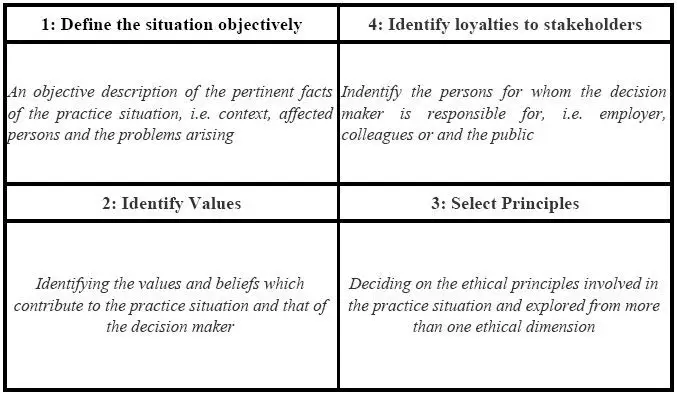
Speaking Truth to Power: Daniel’s Guide to Ethical Leadership
In the gilded halls of ancient Babylon, Daniel faced a critical decision. His audit had uncovered widespread corruption among the
Ethics, at its core, is the study of moral principles that govern human behavior, guiding us in discerning right from wrong. These principles serve as a compass, influencing our decisions and actions in both personal and professional spheres.
Engaging with ethics allows individuals and organizations to navigate complex dilemmas, fostering integrity, trust, and social responsibility.

To systematically approach moral questions, several ethical frameworks have been developed:
This theory posits that the morality of an action is determined by its outcome, advocating for actions that maximize overall happiness or minimize suffering.
This is about doing what creates the most good for the most people. Think of it as a way to measure how much happiness or suffering our choices create. For example, a city might spend money on a public park instead of a private swimming pool because more people can enjoy the park. Utilitarians look at the results of actions rather than the actions themselves. They try to find solutions that help many people, even if those solutions aren’t perfect for everyone. Sometimes this means making tough choices – like closing a factory that pollutes even though workers might lose their jobs, because clean air helps more people in the long run.

Rooted in duty-based ethics, deontology asserts that certain actions are inherently right or wrong, regardless of their consequences. It emphasizes adherence to moral duties and rules.
This is about following moral rules that don’t change, no matter what happens after. Think of it like having a moral rulebook. If the rule says “Don’t lie,” then lying is wrong even if it might help someone feel better. Deontology says some actions are always right or always wrong. For example, stealing is wrong even if you’re stealing food to feed hungry people. This view focuses on doing what’s right because it’s right, not because it leads to good results. It’s about keeping promises, telling the truth, and respecting people’s rights – no matter what.
Focusing on character, virtue ethics encourages individuals to cultivate moral virtues such as honesty, courage, and compassion, guiding behavior through personal integrity rather than specific rules.
Instead of focusing on rules or results, virtue ethics is about being a good person. It asks “What kind of person should I be?” rather than “What should I do?” The goal is to develop good qualities like honesty, courage, kindness, and wisdom. For example, when you see someone drop their wallet, virtue ethics isn’t about rules or results – it’s about being the kind of person who helps others. If you’re truly honest and kind, you’ll return the wallet because that’s just who you are. This view says good actions come naturally from good character.
This perspective highlights the importance of interpersonal relationships and the moral significance of care and empathy in human interactions.
This approach focuses on relationships and taking care of each other. It says that being connected to others is a key part of being human, and our moral choices should consider these connections. Care ethics looks at how our actions affect our relationships with family, friends, coworkers, and even strangers. For example, if a friend needs help moving on the same day as a work meeting, care ethics would consider how important the relationship is and how to best maintain it. This view emphasizes empathy, understanding others’ needs, and maintaining healthy relationships.

Applying ethical theories to real-world scenarios involves:
Personal Ethics: Individuals develop a moral compass based on personal values, cultural influences, and life experiences, guiding daily choices and interactions.
Professional Ethics: Various professions establish codes of conduct to ensure integrity and accountability. For instance, medical ethics prioritize patient welfare, while legal ethics emphasize justice and confidentiality.
Business Ethics: In the corporate realm, ethical practices involve fair treatment of employees, transparent dealings with customers, and social responsibility.
Structured approaches aid in resolving ethical dilemmas:
The Potter Box: A four-step model involving:


Modern advancements introduce new ethical considerations:
Technology and Ethics: The rise of artificial intelligence and digital platforms raises questions about privacy, data security, and the moral implications of automation.
Environmental Ethics: As environmental concerns escalate, discussions focus on sustainability, conservation, and our responsibilities toward the planet.
Bioethics: Medical and biological research present complex ethical dilemmas requiring careful deliberation.
To deepen your understanding of ethics and its various applications, explore the following carefully curated selection of books, articles, and academic resources on the subject.
Daniel as a Blueprint for Navigating Ethical Dilemmas – This book explores how ancient wisdom from the Book of Daniel can inform ethical leadership and decision-making in modern times.
Proverbs for Profit – Examines how ancient proverbs provide ethical insights into business and professional success.
The Elements of Moral Philosophy – By James Rachels & Stuart Rachels, this book is one of the most widely used texts on ethics, providing an engaging introduction to major ethical theories and issues.
Justice: What’s the Right Thing to Do? – By Michael Sandel, this book explores moral and ethical dilemmas through real-world case studies, helping readers develop their own ethical reasoning skills.


Here are some insightful articles on RichardFrench.net that explore ethical issues in leadership, business, and personal decision-making:
When Corporate Values and Culture Collide: The True Cost of Ethical Disconnects – Discusses the risks when company culture deviates from stated values.
The Rise of Stakeholder Capitalism: Redefining Business Ethics in the Modern Era – Examines how businesses are shifting from profit-driven models to more ethical, socially responsible practices.
Speaking Truth to Power: Daniel’s Guide to Ethical Leadership – Uses lessons from the biblical story of Daniel to highlight integrity in leadership.
A Framework for Ethical Decision Making – Santa Clara University’s guide to making ethical decisions using core moral principles.
Are You as Ethical as You Think You Are? – Explores the psychological biases that influence our ethical behavior.
Ethical Concerns Mount as AI Takes Bigger Decision-Making Role – Harvard experts discuss the ethical implications of artificial intelligence and automation.
15 Great Articles and Essays about Ethics and Morality – A compilation of thought-provoking essays on various ethical dilemmas.
Journal of Business Ethics – A leading academic journal featuring peer-reviewed research on business ethics.
Cross-Cultural Ethical Practices: Challenges and Best Practices – Examines how different cultures approach ethics and the challenges in global business.


In the gilded halls of ancient Babylon, Daniel faced a critical decision. His audit had uncovered widespread corruption among the

I’m thrilled to announce the launch of “Proverbs for Profit: Ancient Wisdom for Modern Business Ethics”. In a world where

When crisis strikes, ethical leadership is put to the test. Whether it’s a global pandemic, a product recall, or a

In the bustling corridors of corporate offices, the high-stakes environments of startups, and the complex landscapes of global organizations, today’s

“Daniel as a Blueprint for Navigating Ethical Dilemmas” by Richard French is now available! Are you a leader struggling with
While often used interchangeably, ethics refers to the systematic study of moral principles that govern behavior, whereas morality pertains to personal beliefs about right and wrong, shaped by cultural, religious, and individual factors.
Ethical principles establish standards for behavior, ensuring trust, accountability, and integrity in professional environments. They guide decision-making that respects the rights and dignity of all stakeholders.
Begin by identifying the specific points of conflict and assessing the potential impact of various actions. Engage in open dialogue with supervisors or ethics committees to seek guidance. In some cases, it may be necessary to recuse yourself from certain decisions or, if the conflict is profound, reconsider your role within the organization.
Organizations can foster ethical behavior by implementing comprehensive ethics programs that include:
Cultural backgrounds significantly influence perceptions of ethics. Practices deemed acceptable in one culture may be viewed differently in another. For instance, communication styles vary, affecting how ethical guidelines are conveyed and interpreted, potentially leading to misunderstandings. Additionally, differing ethical standards can result in cultural conflicts during business transactions.
While individuals may have inherent moral inclinations, ethical behavior can and should be cultivated through education and experience. Teaching ethics involves exposing individuals to various moral frameworks, encouraging critical thinking, and providing tools to navigate complex dilemmas. Continuous reflection and dialogue play crucial roles in reinforcing ethical conduct.
The digital era has introduced unique ethical challenges, including:
Navigating these challenges requires a commitment to ethical principles that evolve alongside technological advancements.
The Potter Box is a framework used to analyze and resolve ethical dilemmas systematically. It involves four steps:

Embracing ethics is a continuous journey of reflection and action. By integrating ethical considerations into our daily lives, we contribute to a more just and compassionate society, navigating the complexities of modern life with integrity and wisdom.